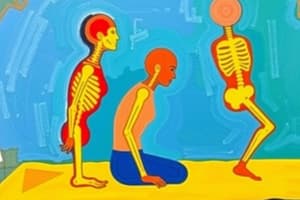Podcast
Questions and Answers
What does MSD stand for?
What does MSD stand for?
musculoskeletal disorders
You should change your working position frequently by:
You should change your working position frequently by:
- Regularly adjusting chair height
- Taking short breaks
- Stretching
- All of the above (correct)
Regardless of how good your working posture is, working in the same posture or sitting for prolonged periods is not healthy.
Regardless of how good your working posture is, working in the same posture or sitting for prolonged periods is not healthy.
True (A)
Hazard prevention and control includes:
Hazard prevention and control includes:
Pushing carries a greater risk of strain and injury.
Pushing carries a greater risk of strain and injury.
Uncontrollable shivering, loss of coordination, and slurred speech are symptoms of what?
Uncontrollable shivering, loss of coordination, and slurred speech are symptoms of what?
Types of heat illness include?
Types of heat illness include?
Implementing an ergonomic process is effective in reducing the risk of developing MSDs in high-risk industries.
Implementing an ergonomic process is effective in reducing the risk of developing MSDs in high-risk industries.
When does Working Restriction Protection end?
When does Working Restriction Protection end?
Reporting symptoms of MSD early does not help in stopping MSD.
Reporting symptoms of MSD early does not help in stopping MSD.
Flashcards are hidden until you start studying
Study Notes
Musculoskeletal Disorders (MSD)
- MSD stands for musculoskeletal disorders, which are injuries or conditions affecting muscles, ligaments, tendons, and nerves.
- Early reporting of MSD symptoms is crucial for prevention and treatment.
Ergonomic Practices
- Regularly changing working positions mitigates the risk of injury and enhances overall health.
- An ergonomic process implementation effectively reduces the risk of MSDs, particularly in high-risk industries.
Workplace Posture
- Maintaining a good working posture is important, but prolonged periods in the same position are detrimental to health.
- Even with good posture, it is essential to avoid sitting or standing still for too long to prevent discomfort and injury.
Hazard Prevention
- Hazard prevention and control involve measures such as administrative and engineering controls to protect workers.
- These strategies are vital in managing workplace risks associated with ergonomics.
Heat Illness
- Types of heat illness include various conditions arising from environmental heat, and it is important to recognize their signs.
- Symptoms of hypothermia include uncontrollable shivering, loss of coordination, and slurred speech, indicating a serious health risk.
Working Restrictions
- Working Restriction Protection ends when an employee can resume their regular position or transition to a new role.
- Understanding the timeline for returning to work is essential for employee safety and compliance.
Strain and Injury Risks
- Contrary to popular belief, pushing does not inherently carry a greater risk of strain and injury compared to pulling or lifting.
- Understanding ergonomic risks associated with physical tasks is essential for promoting workplace safety.
Studying That Suits You
Use AI to generate personalized quizzes and flashcards to suit your learning preferences.




